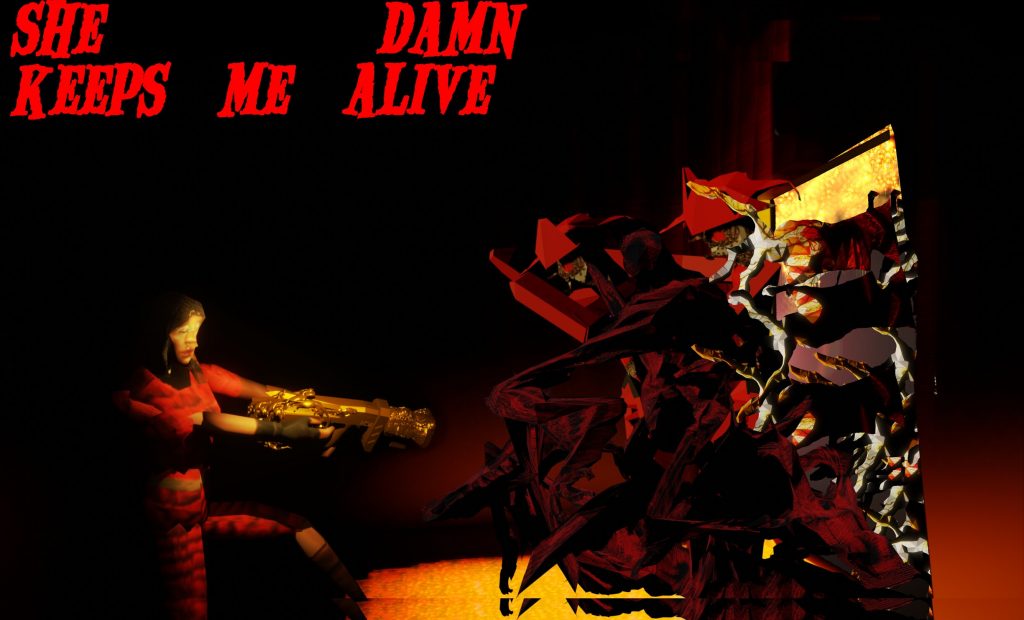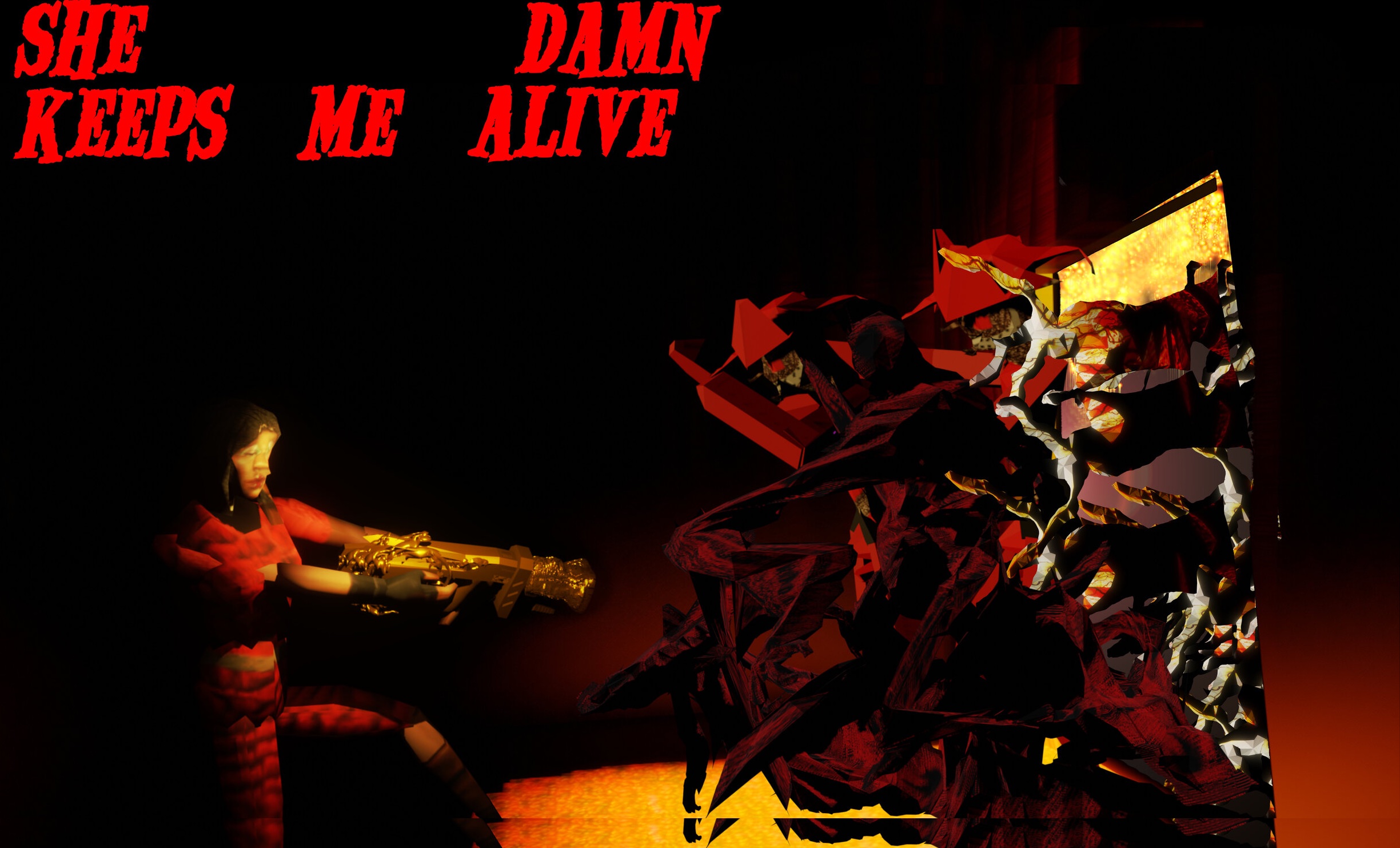Text by Meritxell Rosell

Can you protect black trans people with a gun? With this challenging question visitors of arebyte gallery’s (London) current exhibition are confronted shortly after entering the space.
SHE KEEPS ME DAMN ALIVE by digital artist Danielle Brathwaite-Shirley, centres on a video game that asks the player to question how their choices and actions (or inactions) affect others directly. The show positions the player at the heart of a situation demanding a reflection, an action and ultimately a stance to protect the lives of Black Trans people. This call to action is often prevalent in Danielle’s work and is part of a larger framework of promoting accountability and action surrounding the black trans community and beyond.
By taking part in the game the player also participates in forwarding the ideologies of the Black Lives Matter and Black Trans Lives Matters movements that took precedence worldwide during the pandemic. Speaking of solidarity, honouring lives lost and creating spaces where it is “easier for us to breathe”, are, amongst many others, aims repeated in Danielle’s work.
Danielle shares that the idea for the exhibition began when they were trying to find the most accessible controller method for people to play games. After testing a bunch of different types of controllers, the one that was the most accessible appeared when playing the game “House Of The Dead”. Here the control method was pointing a fake gun and shooting the screen.
They found it alarming that the easiest controller for people to understand was a gun. The idea for She Keeps Me Damn Alive was born: The questions I had were how could I comment on the draw to commit violence in games while also questioning if weapons or violence could be used to protect black trans people.
The exhibition uses the artist’s recent series of DOTCOM works blacktransarchive.com, blacktransair.com and blacktranssea.com as a starting point for furthering research on Archiving the black trans experience via interactivity and storytelling. When asked what has been the most triggering finding they encountered or the most significant value concerning Black Trans people and their current condition while researching for these projects, Danielle says they created the “.com Series” in response to the absence of Black Trans people in the archive:
When looking back on history it’s as though we never existed yet you find clues that we had existed and in fact, have continually had our presence erased. I knew that if we wanted to be remembered for those like us in the future we would have to do it ourselves.
They also mention the question about taking up space online. Most of the internet real estate is not designed by Black Trans people. Their aim is to create an easy-to-find set of sites that have been built from the ground up for us rather than using a predesigned system that didn’t have us in mind, and this is how the “.com Series” was born. Each work was an attempt to archive Black Trans people from a Black Trans perspective working alongside each other and letting us create the process of archiving.
At the same time, they follow, It was very hard to figure out what about ourselves we want to archive in the present but I am hoping as the series expands there will be possible to discover the ways in which we can record our lives for the future generation of Black Trans people.
Talking about the impact the digital and Internet realms have on Black Trans people, Danielle is clear: Just for me personally, the Internet has been an extremely formative place for me. Like many others, I discovered transness (at the time I didn’t know the vocabulary) on various forums and tumblr pages. A Lot of these let me understand that it was possible to live a life as a trans person and that it had been done many times before. At that moment I started to move towards it slowly. However, I was too scared to move towards it physically and instead found places in games to try out things.
I would try out names of myself in pokemon. I would design how I wanted to look in games like dragon’s dogma. I would practice navigating the streets in Urban Chaos. All of this was new and the games I played allowed space for experimentation without repercussion.
Nevertheless, they also think the digital space is very different now and platforms such as Instagram have allowed for a language of BlackTrans aesthetics to grow and converse with each other. One thing they find difficult about the Black Trans internet presence today is that it’s very easy to be visible, for people to like and comment on their appearance, but still very hard to make spaces developed exclusively to support their existence: I think it is definitely easier to find a visual representation of ourselves but we need more than just this and often the understanding or care of us stops at our appearance.
She Keeps Me Damn Alive exhibition encompasses a new body of work that positions gaming at the forefront of ideas surrounding action, inaction, relation and archiving experience. This methodology takes shape as an immersive point-and-shoot style arcade game asking visitors to question how their choices and actions (or inactions) affect others directly. The game uses the interactions of those who play it to recentre their understanding of responsibility; challenging them to see if their sense of when to act and when not to act is sustainable for black trans people.
Other trans artists and academics also use video games as one of their main mediums of expression and topics of research. Micha cárdenas, an artist and theorist working with the algorithms and poetics of trans people of colour, describes how there are multiple similarities between transgender experience and the experience of using multiple realities, such as mixed and alternate reality games, and proposes that artists working with multiple realities can learn from the experiences of trans people, such as inhabiting new bodies and having multiple identities, sometimes simultaneously. Danielle’s work goes a step further and puts not just artists but any exhibition viewers at the centre of experiencing and reflecting on the black trans multidimensionality.
But how can these digital interfaces and altered realities play a positive role in the challenges of redefining gender we face nowadays? For Danielle There are no challenges in redefining gender: It’s not hard to do. It’s just hard for many people to take it seriously. We have a lot of people who refuse to acknowledge our existence in very powerful positions. Name one British politician in parliament that is trans…yeah…
Digital interfaces are useful, but it’s not just about those, it’s about the process of creating those interfaces. It’s about hiring and having black trans people in the teams to give us a foothold in the ever-growing simulations we live within. The larger part that technology has in our lives, the more worried I get about the “behind the scenes”. If white men continue to make tech for everyone else, we soon may have nowhere to go.
The exhibition runs until Saturday 19 February 2022. More info here.






